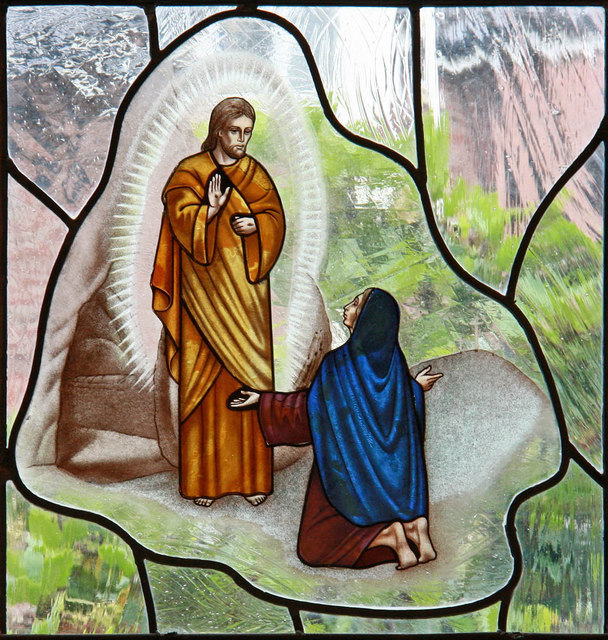
St Michael & All Angels, Jarvis Brook – Stained glass window
© Copyright John Salmon and licensed for reuse under this Creative Commons Licence
The Easter Sunday hymn from sing praise is titled, perhaps predictably, “Alleluia! Christ is Risen”, the shout of triumph and joy echoed by millions of Christians around the world today. This is, though, an unfamiliar hymn to me, written by the American composer Herbert F Brokering. The meters is unusual (9.10.9.10 + 10.9), the hymn book doesn’t offer any alternatives that fit it, and the I found the tune (“Earth and all stars”) a difficult one, even to sing along to a recording found online.
The hymn is in three verses, and is maybe intended to illustrate three ways in which the resurrection can be understood. The first is about the cosmic implications: “Trumpets resounding in glorious light! Splendour, the Lamb, heaven forever!” It is a fact not often mentioned that no-one actually witnessed the resurrection happening inside the sealed tomb, so it must remain a matter of faith, perhaps rightly so. Also, it was not just about completing the redemption of humans from sin, but more about starting to put right the decay of all creation that Paul refers to in Romans 8.
The second verse is about Jesus’ first appearance to the women at the tomb. “Weeping, be gone; Sorrow, be silent: death is defeated and Easter is bright. Angels announce, Jesus is risen!’ Clothe us in wonder, adorn us in light”. It was important for those first witnesses to go and tell what they had experienced, even though they could not make sense of it, but equally important was the transformation of mourning to joy at the sight of Jesus.
The last verse refers to the Emmaus Road story of Easter evening, but is phrased more as explaining the way that we, here and now, can experience the resurrection for ourselves as we learn more about him continue in fellowship with others and share Communion. “Walking the way, Christ walking in us, telling the story to open our eyes; breaking the bread, showing his glory; Jesus our blessing, our constant surprise.”
Cosmic event, immediate appearances to his disciples, and the ongoing transformation of lives through Christian fellowship: these are what we understand as the resurrection of Christ. Happy Easter to anyone who reads this!
I echo Stephen’s comment that the hymn is difficult to sing, and I tried it on the St Luke’s Eccleshill choir for possible use for worship and filming, but they didn’t like it very much so we didn’t schedule it. And, trying to stand back and look at it, I think there are two reasons: the words and the tune. (Sounds like an Eric Morcambe comment: “All the right notes but not necessarily in the right order”?)
About the words, there has to be some internal rationale to tell the writer which particular things s/he should choose to write in his/her verses – and somehow this hymn lacks that. Yes it is about Jesus being risen. But why are there trumpets? Why is the title “the Lamb” particularly highlighted, and how does it link with the word “splendour”? Why “heaven”, when the resurrection is about Jesus appearing again on the EARTH? Verse 3 seems to be about the Road to Emmaus, but verses 1 and 2 aren’t about the lead-up to that story. Is verse 1 perhaps about Revelation 4-5? But then, why doesn’t the hymn continue in that vein if it is? Somehow the words are a random collection of thoughts – true as they are – which aren’t woven into a coherent order.
And about the melody: well, a fundamental principle about melodies is that rising figures denote excitement and mounting joy … but this tune is made up of lots of fragments of falling scales, and apart from a brief snatch in line 5 there isn’t a single rising scale. The very first “Jesus is risen” has the tune descending to the depths rather than ascending to the heights. Tunes are supposed to state a theme and then develop it, but here lines 3-4 exactly repeat lines 1-2 except for the first four notes. It seems very “American” for line 4 to end back in the tonic after an opportunity to go elsewhere. And somehow the rhythm of the very end, although interesting, doesn’t exactly capture the words that have to be sung to it.
And about the harmonies … well I can’t quite put my finger on it, but somehow there is an echo opportunity missed in bar 2 as the bass ought to move in three crotchets; and in bar 6 there ought to be a different chord, or perhaps a different bass line, rather than a return to the tonic in its root position. There is a tiny variation in that bar 12 has a supertonic chord in contrast to bar 4’s submediant, but there is a feeling right through that the harmonies ought to escape the relentless tonic-dominant feeling.
In short – I was unconvinced, and I can see why the choir and Stephen were, even if it is hard to put it exactly into words. “It doesn’t really go anywhere”, said one of them.
Just for information – the history of the hymn seems to be that Herbert Brokering first wrote a hymn “Earth and all stars” which had a constant refrain “Sing to the Lord a new song” in lines 2 and 4 of every verse (see https://digitalsongsandhymns.com/songs/6906 and https://hymnary.org/text/earth_and_all_stars ). David Johnson, a colleague of his, wrote him a tune (which is why the tune has its name). It then seems Herbert liked the tune and decided to write another hymn – this one – but setting a separate syllable on each note of David’s lines 2 & 4.